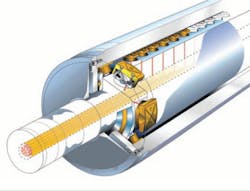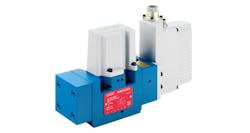The world's largest paper machine, developed by pulp and Metso Paper Inc., Jyvaskyla, Finland, has a wire width of 11.3 m and runs at 2000 m/min ( 75 mph). It is scheduled for startup at the end of this year. How do you control something so large and fast? With digital electrohydraulic valves — more than 600 of them. Moog Inc., Industrial Controls Div., East Aurora, N.Y. is supplying hundreds of their new digital servovalves and servo-proportional valves on this unprecedented machine.
Moog developed its new hydraulic valve platform, Digital Interface Valves, with microprocessor based electronics and fieldbus interface. The valves offer digital flow and pressure control and can replace analog technology. Their configurable functions enable tailoring dynamics of the valve to match particular application requirements. The valves are key to implementing a distributed control concept by allowing tasks to be assigned to local devices rather than through a main control device. providing machines with increased flexibility and functionality.
The servo-proportional valves exhibit a higher frequency response than their predecessors, allowing high spool position loop gain that improves static and dynamic response. This stems from the valve's high natural frequency of its ServoJet pilot stage (500 Hz) and advanced current control algorithms, which is only possible via digital electronics.
The valves also feature improved flow recovery (more than 90% of the pilot stage internal leakage flow), which contributes to energy savings, especially in machines with multiple valves. Plus, high-pressure recovery of the ServoJet pilot stage (more than 80% AP at 100% command signal) produces high spool driving forces to ensure enhanced spool position repeatability.
For more information on Moog's Series 638 digital interface valves or Series D941 Digital pQ servo-proportional valves, call ( 716) 687- 7764, or visit www.moog.com/industrial



